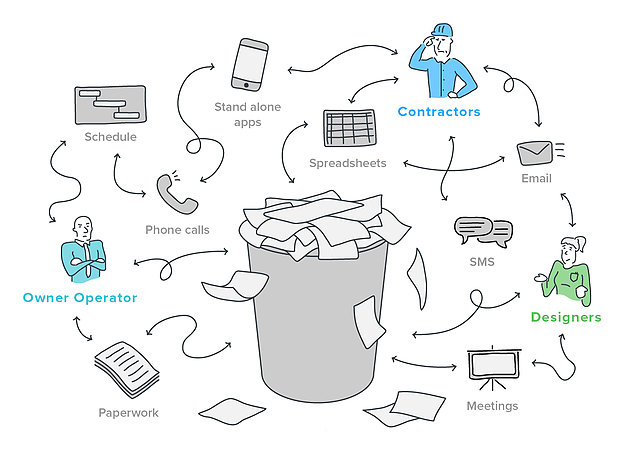Optimizing Task Partnership: Architect's Ideal Practices in Building Record Administration
In the complex world of building tasks, the efficient management of building records stands as a keystone for success. Amidst this complexity lies a vital inquiry: how can architects improve cooperation procedures to improve task end results?
Leveraging Cloud-Based Systems
Leveraging cloud-based systems is a fundamental strategy for modern engineers in maximizing building and construction record monitoring procedures. By transitioning from typical paper-based systems to shadow remedies, engineers can simplify cooperation, enhance file availability, and improve general job efficiency. Cloud-based systems offer engineers the capability to store, share, and update building and construction papers in real-time, making sure that all team participants have accessibility to one of the most present information no matter their area. This access advertises seamless interaction and control amongst job stakeholders, bring about fewer mistakes and delays in the construction procedure.
In addition, cloud-based platforms provide a safe and secure atmosphere for storing delicate project details, using file encryption, regular backups, and customer approval settings to protect information stability. Designers can also gain from the scalability of cloud solutions, allowing them to readjust storage space capacity and capability based on task needs. In general, leveraging cloud-based platforms encourages designers to optimize their building and construction record monitoring procedures, driving greater collaboration, efficiency, and success in their projects.
Implementing Version Control Equipment
Having developed the benefits of cloud-based systems in building paper administration, architects can currently boost their file control processes by carrying out Variation Control Solution. Version Control Solution (VCS) are necessary tools that track modifications in papers, making certain that staff member are constantly collaborating with the current and most exact details. By applying VCS, designers can preserve a centralized repository where all task papers are kept, making it possible for seamless partnership while reducing the danger of errors and variation conflicts.
This function is particularly important in building tasks where design iterations and alterations are usual. This transparency not only improves responsibility however additionally helps in dealing with conflicts or inconsistencies that might arise throughout the job lifecycle.
Developing Communication Methods
To make certain efficient and efficient task sychronisation, architects have to develop clear and robust interaction protocols within their building document management procedures. Interaction procedures specify the methods, regularity, and channels where staff member exchange details, updates, and feedback. One essential element of developing these methods is identifying a centralized communication system where all project-related discussions and document sharing can happen. This system might be a task administration software program, e-mail threads, or cloud-based storage solutions. By establishing standards on how info is distributed and exactly how group members communicate with each other, architects can simplify the circulation of data and stop miscommunications or hold-ups in the building procedure.
Furthermore, interaction procedures ought to likewise include guidelines on exactly how to manage disputes, change orders, and immediate problems that might develop during the project Look At This lifecycle. Developing an organized strategy to interaction makes sure that all stakeholders are on the very same page, promotes transparency, and eventually adds to the effective completion of the building and construction task.
Using BIM Software Application for Control
BIM software program plays a here crucial role in boosting control among task staff member in the construction sector. Building Information Modeling (BIM) assists in collaboration by supplying a central system where engineers, engineers, service providers, and various other stakeholders can interact in a collaborated manner. Through BIM software program, project individuals can access and upgrade a shared model which contains detailed details regarding the structure style, building and construction components, and task schedules.

Moreover, BIM software enables real-time partnership and interaction amongst staff member, despite their physical area. Through cloud-based BIM platforms, job stakeholders can access the most up to date project details, track changes, and make informed choices immediately. Generally, leveraging BIM software program for control enhances job effectiveness, productivity, and eventually causes effective task outcomes.
Ensuring Data Security and Conformity
In the realm of building and construction document monitoring, safeguarding data stability and guaranteeing governing compliance are paramount factors to consider for architects and various other task stakeholders. Architects need to implement robust safety procedures to secure sensitive job details from unapproved accessibility or violations. Utilizing protected cloud storage space options with encryption protocols and gain access to controls can assist minimize risks connected with information theft or loss. Routinely updating software and systems, carrying out safety and security audits, and providing personnel training on information protection finest techniques are important action in preserving a safe and secure setting for construction paper management.

Conclusion
To conclude, architects can enhance job partnership in construction file administration by leveraging cloud-based systems, applying version control systems, establishing interaction protocols, utilizing BIM software for sychronisation, and making certain information safety and security and conformity. These ideal methods aid streamline the construction procedure, improve interaction among project stakeholders, and boost effectiveness in task delivery. By following these guidelines, architects can efficiently take care of construction records and promote successful job end results.
Via BIM software application, job participants can access and upgrade a common version that includes comprehensive information about the structure layout, building and construction components, and task schedules.
Through cloud-based BIM systems, task stakeholders can access the latest task details, track adjustments, and make notified choices promptly - construction document management. Generally, leveraging BIM software for sychronisation improves project effectiveness, productivity, and inevitably leads to successful task results
In verdict, engineers can maximize job collaboration in building and construction document management by leveraging cloud-based systems, executing variation control systems, establishing communication protocols, using BIM software application for control, and making certain information protection and conformity. These ideal methods help enhance the construction process, improve communication among project stakeholders, and boost performance in project delivery.